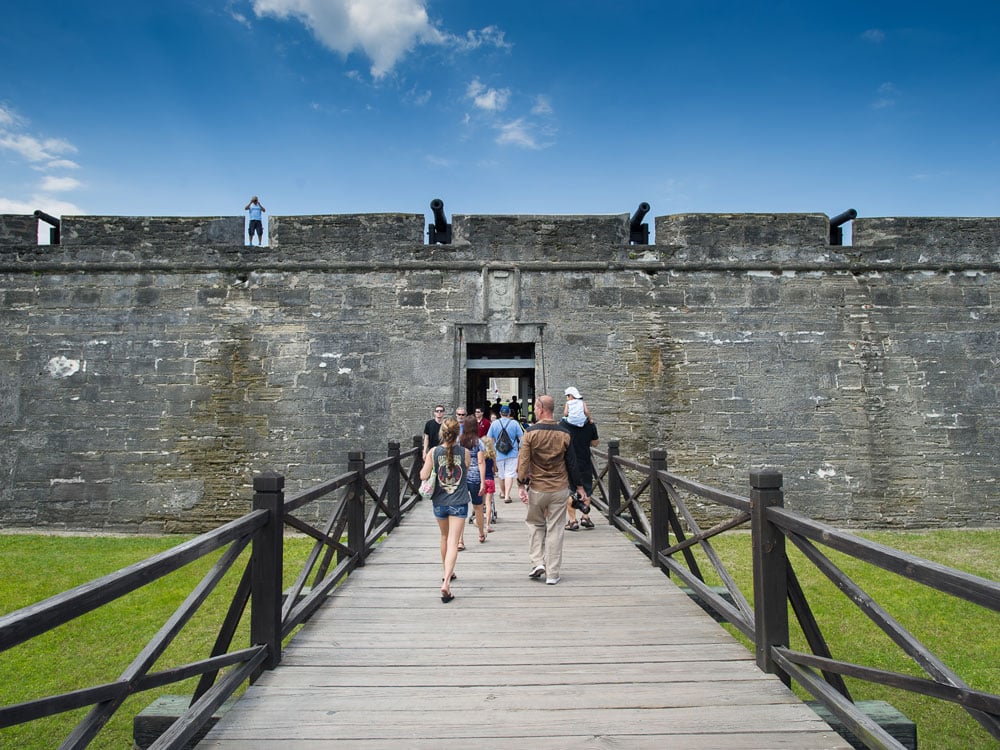Math Lesson | 10 Towns that Changed America Curriculum
Math Lesson
Geometric Analysis

Overview
In this lesson, students will analyze an historic map of St. Augustine from a mathematical standpoint.
Grades: 6 – 12
Time: 1 period
Standards
This lesson addresses selected standards from the Common Core Standards for Mathematics
- Solve real-life and mathematical problems using numerical and algebraic expressions and equations.
CCSS.MATH.CONTENT.7.EE.B.3. Solve multi-step real-life and mathematical problems with positive and negative rational numbers in any form, using tools strategically.
Preparation
To prepare to teach this lesson, teachers should:
- Watch the St. Augustine segment from the PBS special 10 Towns that Changed America, on DVD or online.
- Review the lesson plan.
- Download and print copies of the St. Augustine historic map
- Download and print copies of the analysis worksheet
Lesson
Materials:
- Copies of historic maps of St. Augustine
- Pencils
- Rulers
- Copies of analysis worksheets
Period 1
- Show the St. Augustine segment of 10 Towns that Changed America to the class. Ask students to recall the “Laws of the Indies” from the segment. What were they? (They were really the first urban plan in the Americas, with 148 rules governing how the town should be laid out.) Ask students why they think these laws were important. (Answers will vary, but students should mention the order these laws brought to new towns, the ease of circulation, the ability to organize activities, the way the streets were narrow so as to maximize shade in a tropical climate, etc.)
- Tell students that today they are going to analyze the historic map of St. Augustine to see exactly how detailed the Spaniards got.
- Break students up into pairs. Distribute rulers, historic maps of St. Augustine, and analysis worksheets. (Each pair gets one map, but each student gets his or her own worksheet.)
- Students work through the questions on the worksheet to learn about the plan of St. Augustine.
- Students share their findings.
Additional Resources
Books
- Fairbanks, George R. The Spaniards in Florida.
- Reps, John W. The Making of Urban America: A History of City Planning in the United States.
- Kornwolf, James D. Architecture and Town Planning in Colonial North America.
- Van Campen, J.T. St. Augustine: Florida’s Colonial Capital.
Online Sources
- Laws of the Indies
http://codesproject.asu.edu/sites/default/files/code_pdfs/Laws_of_ind ies.pdf - St. Augustine Historic Background
http://www.nps.gov/nr/travel/american_latino_heritage/St_Augustine Town_Plan_Historic_District.html - Career Applications of Math
http://weusemath.org/?career=urban-planner
For Further Study
This Math lesson can be extended to other subjects or paired with other 10 Towns that Changed America lessons to create the following interdisciplinary connections:
- English Language Arts: The Laws of the Indies featured 148 rules about how a town should be laid out. Devise your own urban planning code for a town of your own invention.
- Art: Using the historic map as the base, students extrude it to draw a 3D, axonometric (seen from a 45 degree angle) view of the city.
- Science: Using the dimensions of the streets that the students promulgated from this lesson, students may make a sun and shadow study to determine how much sun any of the streets in St. Augustine would get, and at what time of day.
- Social Studies: Conduct Internet research about the archaeological digs at Fountain of Youth Park. Students may write a brief report describing one or more of the artifacts unearthed.

